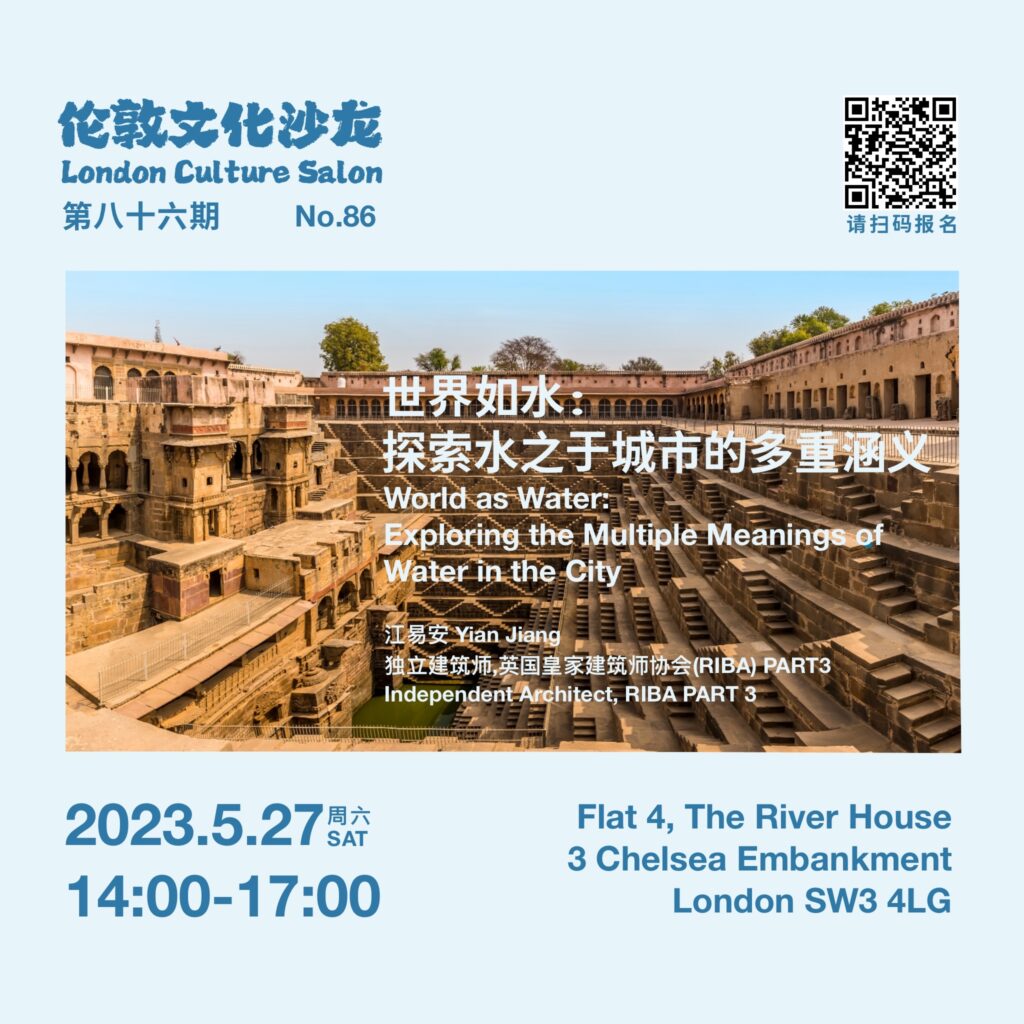【活动时间地点&预订方式】
Sun, 28 May 2023 14:00 – 17:00 BST
Flat 4, The River House, 3 Chelsea Embankment, London SW3 4LG
https://www.eventbrite.co.uk/e/no86-tickets-638879484737
【写在前面】
大概两周前发送了一篇沙龙推文,但是没过一会儿就删除了,原因是主讲人突然发现本来定好的那天又又又遇到了火车罢工,而且是前后两天都在罢工,所以不得已只能改到六月初。还是要跟大家抱歉,尤其是已经订票的朋友,如果至今还没有收到退款的话请在公众号里留言给我。
另外昨天发送了一篇沙龙的推文,但本期沙龙的时间从周六(5月27号)调整为周日(5月28号),时间还是下午2:00到5:00,周日交通不稳定,大家记得早做安排哦。
为近期不稳定的沙龙安排再次抱歉!感谢谅解!
乐人

【内容简介】
我们一直与水共生。人类大脑与心脏73%是水,肺部83%是水,皮肤64%是水,肌肉肾脏79%是水,甚至骨骼中也含有31%的水分。地球表面71%被水覆盖。如此的缘起,让我们似乎永远无法与大自然分割开来。相反地,水成为人类与外界源源不断相互关联的核心介质,在这些关联中,自然景观、城市景观应运而生、不断更迭。
本次讲座将是一场有趣的旅程,笔者将带大家走访世界上与水相生相息的城市空间,去探索水除了作为自然资源以外为城市与建筑带来的更多复杂涵义,尤其是社会及文化上的。抛却历史上承载重要使命的“大江大河”,我们将着重观照那些坐落在邻里,社区,和城市小角落的“小水”,譬如印度兼具宗教性及功能性的阶梯式集水井(Kund/Baori),尼泊尔延续至今的石制地下喷水口(Dhunge dhara),在水源危机中为百姓而建的“礼物”威利斯喷泉(Wallace Fountain)。正是在这些“小水“构筑的场所里,集结出最自然的公共空间,政治和社会的边界得以短暂地消解,精神得以寄托,文化观念和身份得以共识。
然而随着技术和环境的变化,这些“小水”在慢慢的消失,它们是否能在新的环境中保留或赋予新的意义?与此同时,在环境危机的大背景下,水的意义似乎被解读地更具“凶险”。栖息于水的威尼斯,是否一定要随水而去?笔者邀请大家一起来聊聊关于“水”的思考。
“World as Water: Exploring the Multiple Meanings of Water in the City”
Water has always been an integral part of our existence. The human body comprises 73% water in the brain and heart, 83% water in the lungs, 64% water in the skin, 79% water in the muscles and kidneys, and even 31% water in bones. Water covers 71% of the Earth’s surface, making it seemingly impossible for us to separate from nature. Instead, water has become the central medium connecting humans with the external world, giving rise to natural and urban landscapes that evolve over time.
This presentation takes you on an exciting journey to cities worldwide that are intertwined with water, exploring the complex and multiple meanings of water beyond its role as a natural resource for cities and buildings, particularly in social and cultural aspects. In addition to the significant “great rivers” in history, we focus on the “small waters” located in neighbourhoods, communities, and corners of the city, such as India’s religious and functional stepwells (Kund/Baori), Nepal’s stone underground fountains (Dhunge dhara), and the “gifts” of the Wallace Fountain built for the people in times of water crisis. In these places constructed by “small waters,” public spaces are spontaneously created, and political and social boundaries temporarily dissolve, allowing for rituals to be practiced and identities to be reinforced.
However, with changes in technology and the environment, these “small waters” are slowly disappearing. Can they be preserved or given new meanings in the new environment? At the same time, in the context of environmental crises, the meaning of water seems to be interpreted as more “dangerous.” Must Venice, which depends on water, inevitably disappear with it? The author invites everyone to discuss their thoughts on “water.”
【主讲人简介】
江易安,独立建筑师,英国皇家建筑师协会 (RIBA) PART3,毕业于浙江大学建筑系本科,英国谢菲尔德大学硕士。个人网站:www.yianjiang.com
